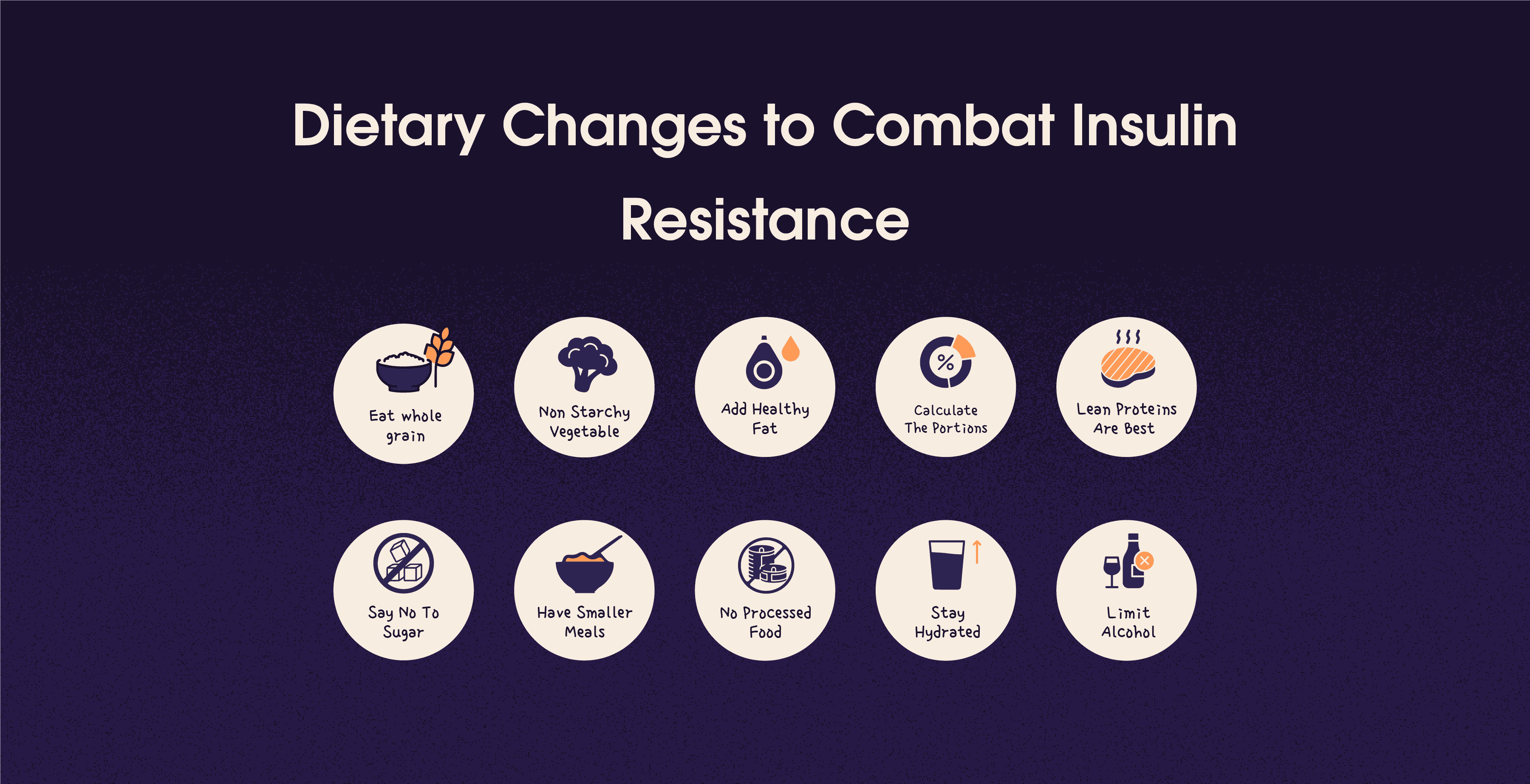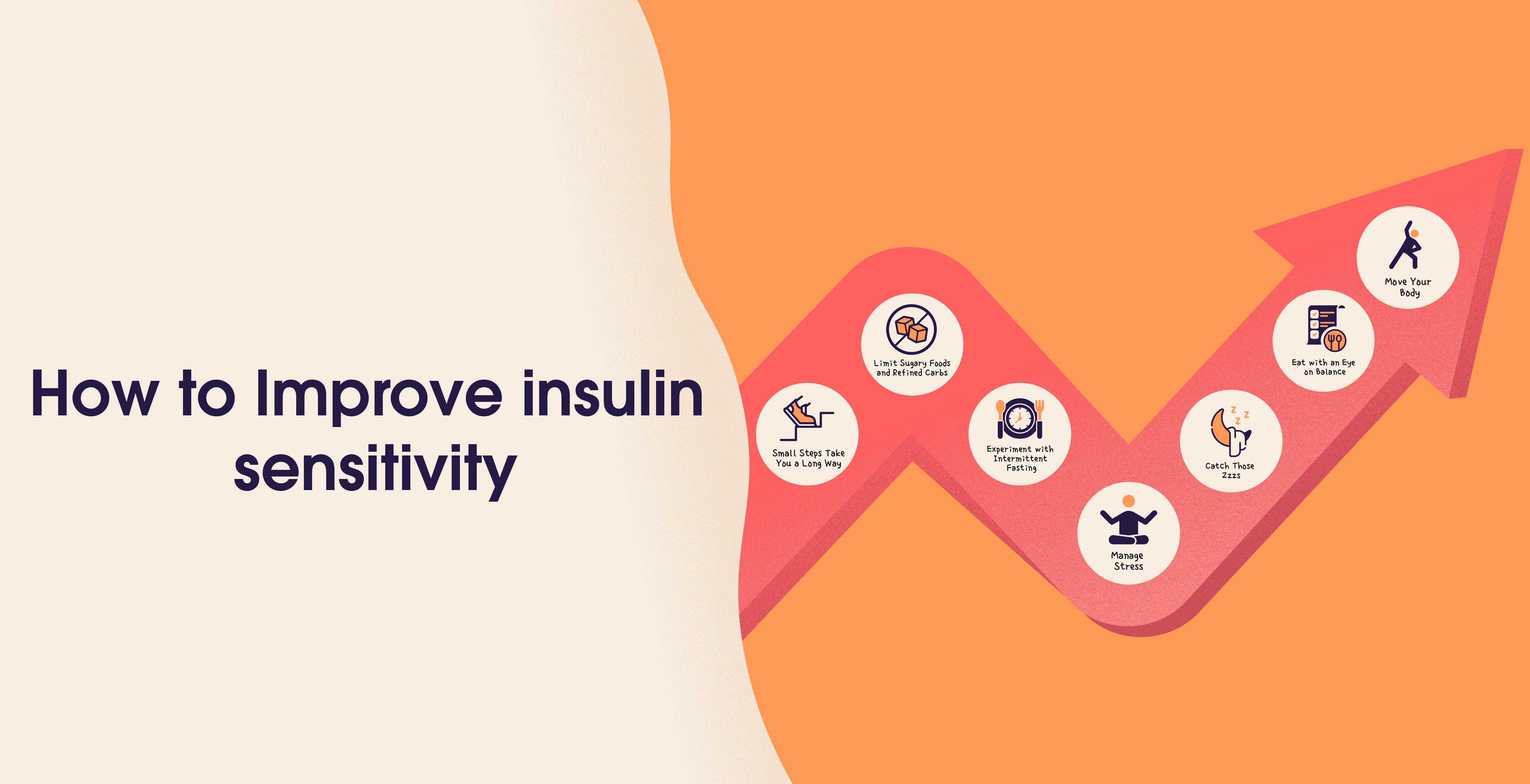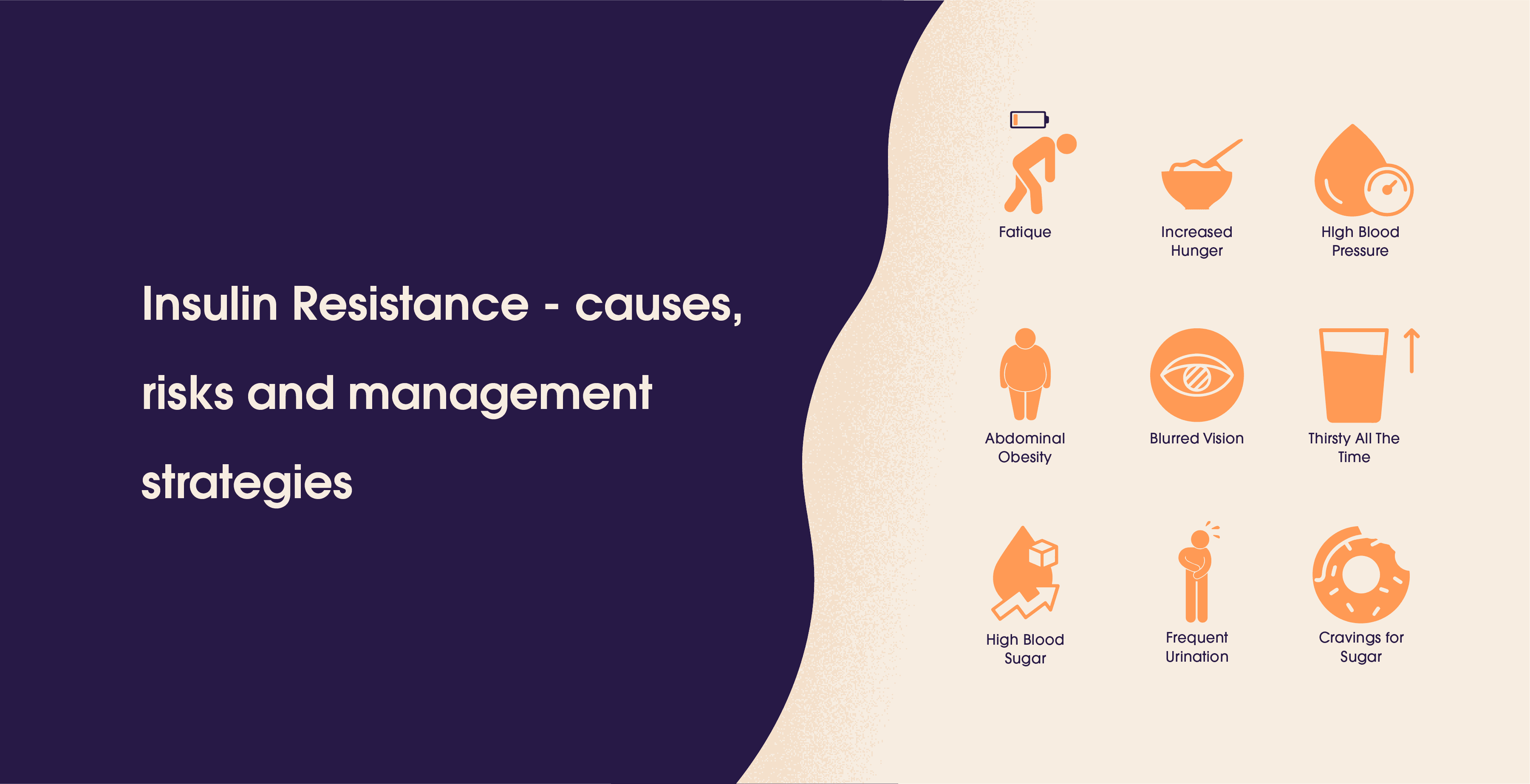Dietary Changes to Combat Insulin Resistance
Sep 20, 2024
Sayfali Rawlani



Table Of Contents
Insulin resistance is your body screaming for help. It occurs when your cells stop processing insulin, a hormone that helps to process sugar into energy. According to a 2021 analysis of the National Health and Nutrition Examination Survey (NHANES), 40% of US adults between 18 and 44 have insulin resistance. Diet plays a major role in controlling insulin resistance. So here is the plan for implementing the changes in your daily routine. Here are some simple dietary changes you can make to help combat insulin resistance.
Highlights
Eat whole grains like brown rice and whole wheat bread. The Refined floor increases the risk of pre diabetes.
Include fiber-rich foods like fruits, veggies, beans, and oats to reduce insulin resistance by 25%.
Use healthy fats like avocados, nuts, seeds, and olive oil to improve insulin sensitivity by 30%.
Go for lean proteins like chicken, fish, tofu, and beans to help keep your blood sugar steady.
Reducing sugary drinks can lower your risk of diabetes by 25%.
Eating smaller meals throughout the day can reduce blood sugar spikes by 20%.
Keep alcohol intake moderate (1 drink/day for women, 2 for men) to avoid a 67% higher risk of insulin resistance.
Fill half your plate with veggies, a quarter with lean protein, and a quarter with whole grains for better blood sugar control.
Make small changes slowly; these are 40% more likely to last than big, sudden changes.
Diet Changes To Follow
Eat Whole Grain Instead Of Refined Food
Refined carbohydrates such as white bread, pasta, and sugar cereals can cause your blood sugar to spike. Instead of these foods, you can choose whole grains such as whole wheat bread (Brown bread), brown rice, and oatmeal. Whole grain foods have more fiber, which simply helps slow down sugar absorption and stabilize your blood sugar level.
Here is a quick tip- Always check out the labels behind the package, it always covers the whole information. Look for the items labeled “whole grain” or “whole wheat” to start with.
Fill Your Bowl With Non Starchy Vegetables
Non-starchy vegetables are low in carbs and calories, but high in fiber and essential nutrients. Eat moreleafy greens like spinach and kale, cruciferous vegetables like broccoli and cauliflower, and colorful options like bell peppers and zucchini. These veggies can help keep you full longer and reduce food cravings. Aim to fill half of your plate with these vibrant veggies with every meal.
Don’t Forget To Add Healthy Fat
Healthy fats can improve insulin sensitivity, they help your body use insulin more effectively. Avocados, nuts, seeds, and olive oil are great sources of healthy fats. Try adding a handful of almonds to your afternoon snack, drizzle some olive oil over your salad, or mash avocado onto whole grain toast for a delicious and satisfying breakfast.
Calculate The Portions of High-Carb Fruits
While fruits are packed with vitamins and fiber, some are higher in sugar than others. If you’re managing insulin resistance, it’s helpful to choose fruits that are lower in sugar, such as berries (like strawberries, blueberries, and raspberries), apples, and pears. You can still enjoy higher-sugar fruits, like bananas or grapes, but try to eat them in smaller portions.
Lean Proteins Are Best
Proteins help you feel full and maintain stable blood sugar levels. Choose lean sources of protein, such as chicken, turkey, fish, tofu, and legumes like beans and lentils. These options are low in unhealthy fats and won’t raise your blood sugar levels. Try incorporating fish like salmon or tuna, which are also rich in omega-3 fatty acids, and known for their heart health benefits.
Say No To Sugar And Sugary Beverage
Sugary drinks like flavored soda, sweet tea, or even some fruit juices can cause a quick spike in blood sugar levels. It’s best to drink water, unsweetened tea, or sparkling water flavored with a splash of lemon or lime. When you crave something sweet, opt for a piece of fruit or a small serving of dark chocolate instead of reaching for candies, desserts, or sugary beverages.
Have Smaller Meals
Instead of three large meals, try eating smaller, more frequent meals throughout the day. This approach can help keep your blood sugar levels steady. For example, have a balanced breakfast with whole grains and protein, enjoy a small handful of nuts or a piece of fruit for a snack, and continue with moderate-sized meals throughout the day.
Say No To Processed Food
Processed foods, like packaged snacks, ready-to-eat meals, and fast food, often contain high amounts of added sugars, unhealthy fats, and refined carbs—all of which can worsen insulin resistance. When possible, cook meals at home using whole, fresh ingredients. Simple recipes with fresh vegetables, lean proteins, and healthy fats are not only delicious but also beneficial in managing insulin resistance.
Stay Hydrated
Drinking enough water is crucial for your overall health, and it can also help control your blood sugar levels. When you’re well-hydrated, your kidneys can more effectively flush out excess sugar through urine. Aim for at least 8 glasses of water a day. If you find plain water boring, try adding slices of cucumber, mint leaves, or berries to give it a refreshing twist!
Limit Alcohol Consumption
Alcohol can affect your blood sugar levels in unpredictable ways. If you drink, do so in moderation. Choose options like dry wine or spirits mixed with soda water instead of sugary cocktails or beer. Also, make sure to eat when you drink, as alcohol can cause blood sugar to drop suddenly.
Start Small and Stay Consistent
Making these changes might feel overwhelming at first, but remember, you don’t have to do it all at once. Start by picking one or two tips that feel doable, and gradually add more as you feel ready. Over time, these small changes can have a big impact on your health and help manage insulin resistance more effectively.
Why It Matters
Managing insulin resistance with these dietary changes isn’t just about preventing diabetes; it’s about feeling better every day. You’ll have more energy, feel less hungry, and lower your risk for other health problems like heart disease. Plus, you’ll discover delicious new foods and flavors that you might not have tried before! With these small adjustments, you’re taking big steps toward better health and a brighter future!
Insulin resistance is your body screaming for help. It occurs when your cells stop processing insulin, a hormone that helps to process sugar into energy. According to a 2021 analysis of the National Health and Nutrition Examination Survey (NHANES), 40% of US adults between 18 and 44 have insulin resistance. Diet plays a major role in controlling insulin resistance. So here is the plan for implementing the changes in your daily routine. Here are some simple dietary changes you can make to help combat insulin resistance.
Highlights
Eat whole grains like brown rice and whole wheat bread. The Refined floor increases the risk of pre diabetes.
Include fiber-rich foods like fruits, veggies, beans, and oats to reduce insulin resistance by 25%.
Use healthy fats like avocados, nuts, seeds, and olive oil to improve insulin sensitivity by 30%.
Go for lean proteins like chicken, fish, tofu, and beans to help keep your blood sugar steady.
Reducing sugary drinks can lower your risk of diabetes by 25%.
Eating smaller meals throughout the day can reduce blood sugar spikes by 20%.
Keep alcohol intake moderate (1 drink/day for women, 2 for men) to avoid a 67% higher risk of insulin resistance.
Fill half your plate with veggies, a quarter with lean protein, and a quarter with whole grains for better blood sugar control.
Make small changes slowly; these are 40% more likely to last than big, sudden changes.
Diet Changes To Follow
Eat Whole Grain Instead Of Refined Food
Refined carbohydrates such as white bread, pasta, and sugar cereals can cause your blood sugar to spike. Instead of these foods, you can choose whole grains such as whole wheat bread (Brown bread), brown rice, and oatmeal. Whole grain foods have more fiber, which simply helps slow down sugar absorption and stabilize your blood sugar level.
Here is a quick tip- Always check out the labels behind the package, it always covers the whole information. Look for the items labeled “whole grain” or “whole wheat” to start with.
Fill Your Bowl With Non Starchy Vegetables
Non-starchy vegetables are low in carbs and calories, but high in fiber and essential nutrients. Eat moreleafy greens like spinach and kale, cruciferous vegetables like broccoli and cauliflower, and colorful options like bell peppers and zucchini. These veggies can help keep you full longer and reduce food cravings. Aim to fill half of your plate with these vibrant veggies with every meal.
Don’t Forget To Add Healthy Fat
Healthy fats can improve insulin sensitivity, they help your body use insulin more effectively. Avocados, nuts, seeds, and olive oil are great sources of healthy fats. Try adding a handful of almonds to your afternoon snack, drizzle some olive oil over your salad, or mash avocado onto whole grain toast for a delicious and satisfying breakfast.
Calculate The Portions of High-Carb Fruits
While fruits are packed with vitamins and fiber, some are higher in sugar than others. If you’re managing insulin resistance, it’s helpful to choose fruits that are lower in sugar, such as berries (like strawberries, blueberries, and raspberries), apples, and pears. You can still enjoy higher-sugar fruits, like bananas or grapes, but try to eat them in smaller portions.
Lean Proteins Are Best
Proteins help you feel full and maintain stable blood sugar levels. Choose lean sources of protein, such as chicken, turkey, fish, tofu, and legumes like beans and lentils. These options are low in unhealthy fats and won’t raise your blood sugar levels. Try incorporating fish like salmon or tuna, which are also rich in omega-3 fatty acids, and known for their heart health benefits.
Say No To Sugar And Sugary Beverage
Sugary drinks like flavored soda, sweet tea, or even some fruit juices can cause a quick spike in blood sugar levels. It’s best to drink water, unsweetened tea, or sparkling water flavored with a splash of lemon or lime. When you crave something sweet, opt for a piece of fruit or a small serving of dark chocolate instead of reaching for candies, desserts, or sugary beverages.
Have Smaller Meals
Instead of three large meals, try eating smaller, more frequent meals throughout the day. This approach can help keep your blood sugar levels steady. For example, have a balanced breakfast with whole grains and protein, enjoy a small handful of nuts or a piece of fruit for a snack, and continue with moderate-sized meals throughout the day.
Say No To Processed Food
Processed foods, like packaged snacks, ready-to-eat meals, and fast food, often contain high amounts of added sugars, unhealthy fats, and refined carbs—all of which can worsen insulin resistance. When possible, cook meals at home using whole, fresh ingredients. Simple recipes with fresh vegetables, lean proteins, and healthy fats are not only delicious but also beneficial in managing insulin resistance.
Stay Hydrated
Drinking enough water is crucial for your overall health, and it can also help control your blood sugar levels. When you’re well-hydrated, your kidneys can more effectively flush out excess sugar through urine. Aim for at least 8 glasses of water a day. If you find plain water boring, try adding slices of cucumber, mint leaves, or berries to give it a refreshing twist!
Limit Alcohol Consumption
Alcohol can affect your blood sugar levels in unpredictable ways. If you drink, do so in moderation. Choose options like dry wine or spirits mixed with soda water instead of sugary cocktails or beer. Also, make sure to eat when you drink, as alcohol can cause blood sugar to drop suddenly.
Start Small and Stay Consistent
Making these changes might feel overwhelming at first, but remember, you don’t have to do it all at once. Start by picking one or two tips that feel doable, and gradually add more as you feel ready. Over time, these small changes can have a big impact on your health and help manage insulin resistance more effectively.
Why It Matters
Managing insulin resistance with these dietary changes isn’t just about preventing diabetes; it’s about feeling better every day. You’ll have more energy, feel less hungry, and lower your risk for other health problems like heart disease. Plus, you’ll discover delicious new foods and flavors that you might not have tried before! With these small adjustments, you’re taking big steps toward better health and a brighter future!
Table Of Contents
Table Of Contents
Table Of Contents
Read More


Nov 6, 2024
Sayfali Rawlani


Sep 16, 2024
Aparna Hurtis



Company
Copyright © 2025 trst health. All right reserved.
